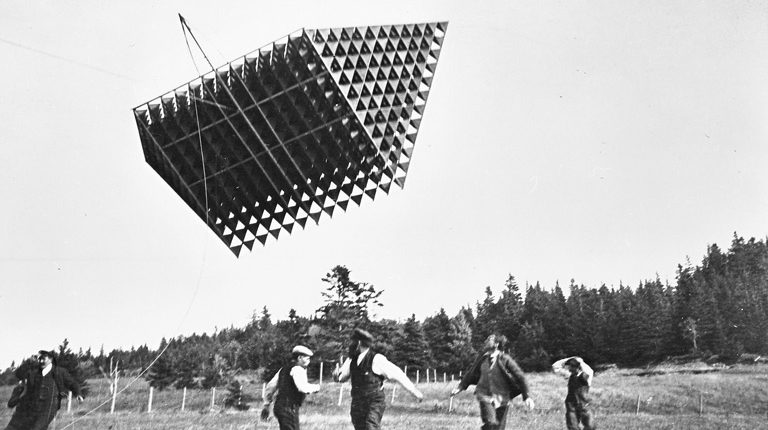“I have no doubt that a machine will be driven from the Earth’s surface at enormous velocities by a new method of propulsion – think of tremendous energies locked up in explosives – what if we could utilize these in projectile flight!”
— Alexander Graham Bell in 1915
He made outstanding contributions to aviation, particularly through his development of tetrahedral kites, the investigation of their application to personnel carrying aircraft, and his enlistment of talented associates who aided significantly in the progress toward accomplishing powered flight.
His summer home at Baddeck, Nova Scotia, afforded excellent conditions for his scientific interest in flying kites. It is here, over the next three and a half decades that Bell delves deep into the fanciful and futuristic – rockets, heavier than air flying machines, water distillation, tetrahedral towers, sheep breeding, hydrofoil boats and more.
Expanding upon the design of the rectangular-celled box kite that Hargrave of Australia invented, Dr. Bell developed a three-sided triangular form of cell which he adapted to various multi-cellular shapes. This research led to a large kite in which on December 6th, 1907, his associate, Lt. Thomas Selfridge, flew to a height of over 160 feet.
He developed the tetrahedral cell with aerodynamic lift and tested a variety of kites formed with these cells. His “Cygnet” kite flew for seven minutes at a height of 168 feet with a man on board in 1907.
“Dr. Bell’s theory of a flying-machine differs from other aeronauts, inasmuch as he claims that the kite-principle is the only one by which the air can be successfully navigated, and it is along this line that he has been conducting his experiments.” (Thomas Johnson, The Canadian Magazine, v.xx, no. 4, February 1903)
In June 1903 Bell published The Tetrahedral Principle in Kite Structure in the National Geographic Magazine (XlV No.6). In this article Bell stated: “I have been continuously at work upon experiments relating to kites. Why, I do not know, excepting perhaps because of the intimate connection of the subject with the flying-machine problem.” “I have had the feeling that a properly constructed flying machine should be capable of being flown as a kite; and conversely, that a properly constructed kite should be capable of use as a flying-machine when driven by its own propellers. I am not so sure, however, of the truth of the former proposition as I am of the latter.”









